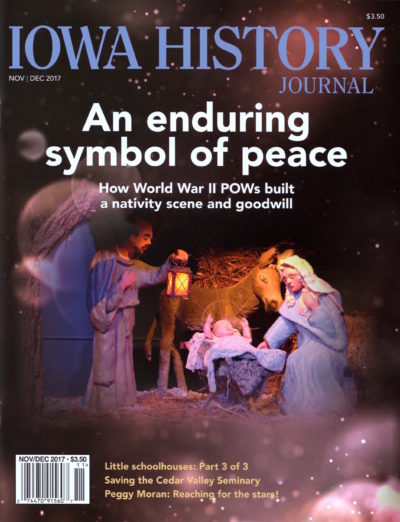
The Algona Nativity Scene was created by German prisoners of war at Camp Algona during World War II. The POWs built it in time for Christmas in 1945 and when the war ended, they donated it to the town as a gesture of goodwill. It includes 65 figures and is under the care of the Algona First United Methodist Church. Photo courtesy of Camp Algona POW Museum
By John Skipper
This is more than a story of war and peace. Rather, it is a story of war and peace on earth — goodwill toward men — in the most unlikeliest of places, a prisoner of war (POW) camp in Algona during World War II.
Algona, with a population of about 5,500, is the county seat of Kossuth County, the largest county in the state in terms of area, bordering Minnesota at its northernmost part. It is a county dotted with small towns as Algona was (and still is) the only city with more than 1,000 people.
Between the end of 1942 and 1946, there were nearly 400,000 prisoners in POW camps throughout 48 states in the the United States. All were from nations with whom the U.S. was at war, mostly Germany. The prisoners in these camps were young men who were thousands of miles from their families and jobs, doing their duty in answering the call of their country. They were not evil. They were the pawns of evil.
Camp Algona was built in about three months and operated from April 1944 to February 1946. During its tenure it housed about 10,000 German POWs. Though the war ended several months earlier, it took time to disassemble the camp and make arrangements for the nearly 2,000 prisoners housed there.
The complex in Algona served as a base camp that had 34 branch camps stretching across Iowa and into Minnesota and Nebraska. The prisoners were kept active and healthy by putting them to work on farms, in canneries, nurseries and plants; detassling corn, cutting timber and building structures.
Many of the prisoners had skills they had developed in their home countries. Every effort was made to have them use those skills, but they were not to take the jobs of Americans. Instead, they formed a labor force that was used to fill the gaps created by Americans going off to war. They were paid for their work and could purchase items at canteens run by the prisoners.
The first German prisoners arrived at Camp Algona in April 1944. One of them was Eduard Kaib (pronounced “Kibe”), an architect in his homeland and a non-commissioned officer in the German Army. As the Christmas season approached, Kaib became restless and homesick. Instead of being home celebrating the holiday season with his loved ones, he was in some place called Algona, Iowa, which might as well have been the end of the earth to him.
Kaib was a religious man and was a gifted craftsman. To pass the time, he decided to build a small nativity scene, making the figures out of soil that were baked in an oven to harden them and make them sturdy. He then placed them delicately in a 12-foot platform he had built.
The display caught the attention of Camp Commander Lt. Col. Arthur Lobdell, who noticed the figures in the display Kaib had set up in the prisoners’ quarters. Lobdell was so impressed that he invited Kaib to his office to learn more about how the young German architect had designed and built the display. By the end of their conversation, Lobdell asked Kaib if he would consider building a larger nativity scene. As a non-commissioned German officer, Kaib was not required to work outside the camp, milking cows and detassling corn as so many of his comrades were doing, so he would have the time to do the project.
Perhaps Kaib was motivated by the thought of creating something bigger and better to satisfy his own creative interests, or maybe the young prisoner of war just wanted to please the man in charge of the camp. For whatever reasons, Kaib agreed to take on the project.
TO READ MORE ABOUT THIS STORY AND OTHER FASCINATING STORIES ABOUT IOWA HISTORY, subscribe to Iowa History Journal. You can also purchase back issues at the store.
